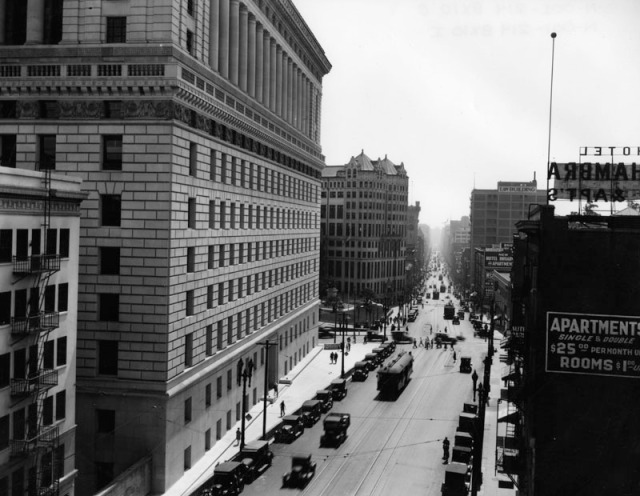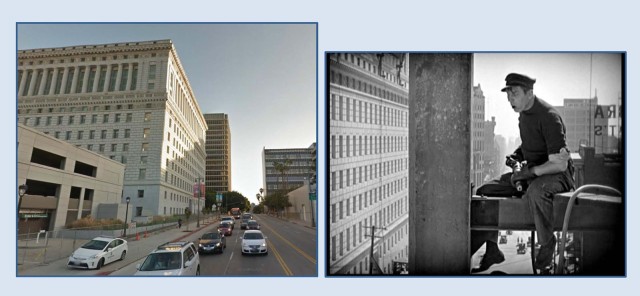 Although most of The Big Parade (1925) is set in the war-torn villages and battlefields of France, the acclaimed World War I drama also provides historic views of early downtown Los Angeles and Orange County. Told from the soldier’s point of view, the epic movie directed by King Vidor follows a trio of men from different walks of life brought together by combat.
Although most of The Big Parade (1925) is set in the war-torn villages and battlefields of France, the acclaimed World War I drama also provides historic views of early downtown Los Angeles and Orange County. Told from the soldier’s point of view, the epic movie directed by King Vidor follows a trio of men from different walks of life brought together by combat.
Set in the Spring of 1917, the movie intertitles describe America then as a nation occupied in peaceful progression. Mills were humming with activity while buildings climbed skyward, monuments to commerce.

America’s buildings climbing skyward – the extant Barker Brothers Building at 7th and Flower. LAPL.
 The three male leads are introduced by their professions. Construction worker “Slim” (Karl Dane) is one of labor’s millions, building a nation, Bowery saloon-keeper “Bull” (Tom O’Brien) is a man of another trade, while idle “rich man’s son” James Apperson (John Gilbert) scoffs at ever taking over the helms of his father’s mill. Together these unlikely friends bond through the horrors of war.
The three male leads are introduced by their professions. Construction worker “Slim” (Karl Dane) is one of labor’s millions, building a nation, Bowery saloon-keeper “Bull” (Tom O’Brien) is a man of another trade, while idle “rich man’s son” James Apperson (John Gilbert) scoffs at ever taking over the helms of his father’s mill. Together these unlikely friends bond through the horrors of war.

A matching Los Angeles Public Library photo taken from above the Broadway Tunnel. LAPL

The effect of Slim working high in the air was created by building a simple construction set overlooking the south portal of the former Broadway Tunnel. The star marks where the set stood. USC Digital Library.
The effect of Karl Dane working high in the air was created by building a simple construction set on the terrace overlooking the south portal of the Broadway Tunnel. The camera captured the city streets far below in the background, but cut off the bottom of the set standing on the terrace. This technique was used repeatedly during the silent era, especially for stunt climbing comedies. At the time downtown Los Angeles had five major tunnels; the “upper” Hill Street Tunnel that ran under Fort Moore Hill between Temple and Sunset, the “lower” Hill Street Tunnel that ran under Court Hill between 1st and Temple, the 2nd Street Tunnel, the 3rd Street Tunnel alongside the Angels Flight incline railway, and the Broadway Tunnel that also ran under Fort Moore Hill from between California Street (near Temple) and Sunset, as shown here. The south portal of the Hill Street Tunnel is where Harold Lloyd filmed three of his stunt comedies, as described in this post. Other posts shows how the tunnels are situated to each other, and how they fit in with film noir classics such as Criss Cross (1949). The Broadway Tunnel was demolished in the 1950s. Only the 2nd Street and 3rd Street Tunnels remain.

This 1940 model of downtown Los Angeles on display at the Natural History Museum shows the view from the former Broadway Tunnel overlook towards the Hall of Records Building (arrow), now demolished. The star marks where Karl’s construction site set was built.
 The movie kicks into gear when John Gilbert’s character James witnesses a parade around his home town square. Caught up in the fervor, tapping his feet to the militaristic music, John is easily persuaded to enlist by a group of his enthusiastic friends. The parade scenes were filmed in the heart of Orange County at Plaza Square in Orange, California, marking the intersection of Glassell Street and Chapman Avenue, named for the two founders of the city.
The movie kicks into gear when John Gilbert’s character James witnesses a parade around his home town square. Caught up in the fervor, tapping his feet to the militaristic music, John is easily persuaded to enlist by a group of his enthusiastic friends. The parade scenes were filmed in the heart of Orange County at Plaza Square in Orange, California, marking the intersection of Glassell Street and Chapman Avenue, named for the two founders of the city.

John Gilbert drives west on Chapman Avenue towards Plaza Square. At back is the Odd Fellows hall under construction at the NE corner of Chapman and Orange. The yellow box marks the upper floor balcony. The red box shows the corner of the former First Christian Church, discussed further below, that once stood on the SE corner of Grand and Chapman.

An aerial view of Plaza Square. John Gilbert drives west along E. Chapman Avenue, top arrow, and stops at the oval. The other arrows show the fields on view presented in the movie. The corner of the former First Christian Church (red box) appears in the movie frame above. LAPL.

A view towards the Dittmer’s Mission Pharmacy building. The building once had a circular corner tower that was removed when the building was upgraded with an Art Deco style. The side window patterns remain unchanged.

This elaborate fountain once stood at the center of Plaza Square. It appears behind the drummer in this shot. The fountain has since been relocated to the NW corner of the Orange Public Library. USC Digital Library.

John Gilbert beside the former bank building at 107 E. Chapman Avenue. A more modern bank building stands at this corner today. Orange Public Library and History Center.
The Big Parade would prove to be one of the biggest hits of the silent-film era. Although remembered for humanizing the tragedy of war, it also preserves a bit of Southern California history as well.
For more images of the square you can visit Nathan Masters’s post How the City of Orange Circled Its Towne Square. The Big Parade (C) 1925 Metro-Goldwyn-Mayer. Color street images (C) 2014 Google.





The fountain from the Orange Plaza still exists. It can be found at the Orange Public Library a few blocks down on Chapman.
LikeLike
Thanks so much Melanie – I can see it on Google Street View. I updated my post – thanks again, John
LikeLike
Reblogged this on Paula's Cinema Club and commented:
John Bengtson does the most amazing detective work, tracking down the locations where your favorite silents were filmed.
LikeLike
I know there have been several movies filmed in and near this location including Tom Hanks That Thing You Do (1996) but I never knew they filmed anything this far back in time. Thanks for posting the photos.
LikeLike
Thanks Tom for that information. The square is so photogenic, and such a classic small town America setting, that I would imagine it’s been used in dozens of films.
LikeLike